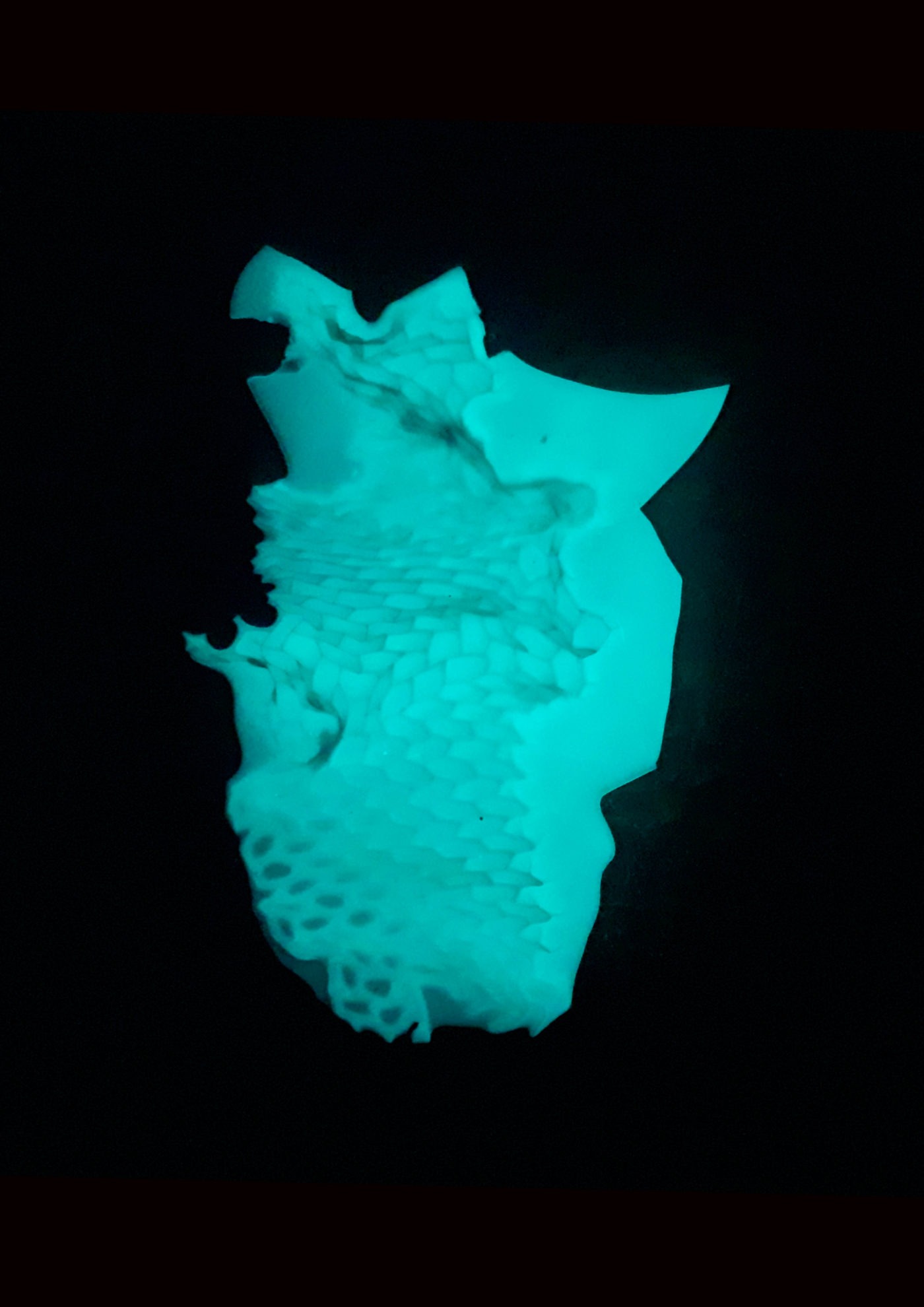Estrid Lutz
Toxins
28 Sep - 10 Nov 2018
ESTRID LUTZ
Toxins
28 September – 10 Nov. 2018
Future Gallery is honoured to present the first solo exhibition of French artist Estrid Lutz, born 1989 in Sarajevo (Bosnia and Herzegovina) and currently living and working in Marseille.
“Toxins” will include new material collages and sculptures which are designed from a broad range of high-tech, resistant and lightweight materials including Kevlar, honeycomb aluminum, carbon fibre, fibreglass and epoxy resin. The materials are commonly used when manufacturing satellites, automobiles, or large scale communication devices. Combining these with photoluminescent liquids the artist creates new hybrid objects, that despite their raw industrial materiality, form organic shapes and textures akin reptile skin. Mysteriously glowing in the dark in shades of blue and green – reminiscent of cyanobateria – the motionless objects installed in the gallery seem to become animated to life.
Lutz is driven by ideas like the transformation from living to dead material and vice versa which can be found in books such as Nicolas Bourriaud’s book “The Exform” (2016). Nowadays the user of technical devices, such as computers and smartphones are considering the gadgets inherent expiry date before purchasing it. The artist herself is seeking for an uncanny ambivalence between electronic waste and a possibility of emerging spirits, that might inhabit the devices. Exemplemary of this approach is the motherboard sculpture, where parts of expired printed circuit boards and an animal spine are combined. In the large scale lenticular collage “honeymoons”. The materials’ ability to endure aggression and deconstructive processes, is revealing the potential resistance of the used fibres in an engaged human-cyborg relationship.
The title “Toxins” refers not only to the obsolescence towards our current ecological deterioration but also an activation of materials processes in the artists ‘lab’ which are by enlarge highly toxic chemical endeavors such a fusing resion with ink and photo-luminescent powders, a sort of techno bricolage. The impact of modified lived realities and confrontation with advanced technology and modern war machines are reflected through their engagement with organisms represented by cellular structures evoking images of bionic cyborgs and raising the question of the toxicity of the absolute unification of nature and technology. Compositions within the art work and its’ jaded edges create an atmosphere of brutality, destruction and loneliness experienced both on and off screen. It is how the emotional human body and mind are altered in a physically disconnected, yet globally conscious time, that is at the core of Lutz’s work.
Lutz recent exhibitions such as: Jelato Love, Palma de Mallorca (2018); exhibitions with Emile Mold include: Kunstverein Arnsberg, Arnsberg (2018); Future Gallery, Berlin (2017); The Composing Rooms, Berlin (2016); and group exhibitions: ‘Crash Test’ at La Panacée, Montpellier (2018); Rowing Projects, London (2016); Dog piss protection board, Beijing and MAMO (2015); Cité Radieuse Le Corbusier, Marseilles (2015).
Toxins
28 September – 10 Nov. 2018
Future Gallery is honoured to present the first solo exhibition of French artist Estrid Lutz, born 1989 in Sarajevo (Bosnia and Herzegovina) and currently living and working in Marseille.
“Toxins” will include new material collages and sculptures which are designed from a broad range of high-tech, resistant and lightweight materials including Kevlar, honeycomb aluminum, carbon fibre, fibreglass and epoxy resin. The materials are commonly used when manufacturing satellites, automobiles, or large scale communication devices. Combining these with photoluminescent liquids the artist creates new hybrid objects, that despite their raw industrial materiality, form organic shapes and textures akin reptile skin. Mysteriously glowing in the dark in shades of blue and green – reminiscent of cyanobateria – the motionless objects installed in the gallery seem to become animated to life.
Lutz is driven by ideas like the transformation from living to dead material and vice versa which can be found in books such as Nicolas Bourriaud’s book “The Exform” (2016). Nowadays the user of technical devices, such as computers and smartphones are considering the gadgets inherent expiry date before purchasing it. The artist herself is seeking for an uncanny ambivalence between electronic waste and a possibility of emerging spirits, that might inhabit the devices. Exemplemary of this approach is the motherboard sculpture, where parts of expired printed circuit boards and an animal spine are combined. In the large scale lenticular collage “honeymoons”. The materials’ ability to endure aggression and deconstructive processes, is revealing the potential resistance of the used fibres in an engaged human-cyborg relationship.
The title “Toxins” refers not only to the obsolescence towards our current ecological deterioration but also an activation of materials processes in the artists ‘lab’ which are by enlarge highly toxic chemical endeavors such a fusing resion with ink and photo-luminescent powders, a sort of techno bricolage. The impact of modified lived realities and confrontation with advanced technology and modern war machines are reflected through their engagement with organisms represented by cellular structures evoking images of bionic cyborgs and raising the question of the toxicity of the absolute unification of nature and technology. Compositions within the art work and its’ jaded edges create an atmosphere of brutality, destruction and loneliness experienced both on and off screen. It is how the emotional human body and mind are altered in a physically disconnected, yet globally conscious time, that is at the core of Lutz’s work.
Lutz recent exhibitions such as: Jelato Love, Palma de Mallorca (2018); exhibitions with Emile Mold include: Kunstverein Arnsberg, Arnsberg (2018); Future Gallery, Berlin (2017); The Composing Rooms, Berlin (2016); and group exhibitions: ‘Crash Test’ at La Panacée, Montpellier (2018); Rowing Projects, London (2016); Dog piss protection board, Beijing and MAMO (2015); Cité Radieuse Le Corbusier, Marseilles (2015).

